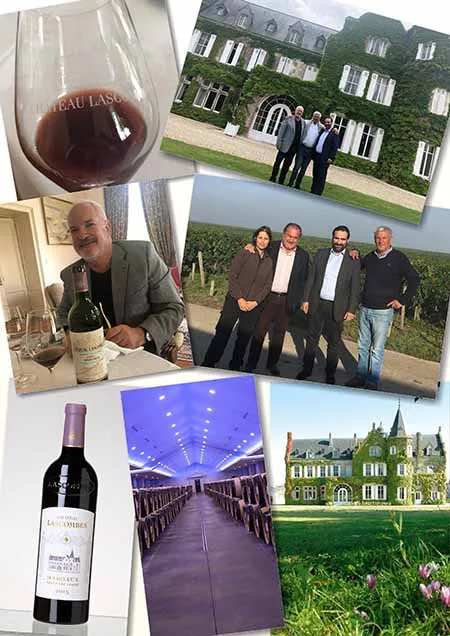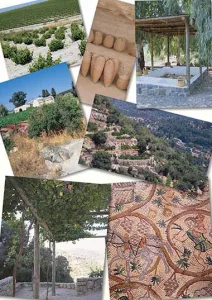Chateau Lascombes is a grand, ivy colored, turreted building in the village of Margaux in the Haut Medoc. It looks grand and imposing, just like a Bordeaux French Château should. The first known owner was Chevalier Antoine de Lascombes, born in 1625. In the famous 1855 classification, Bordeaux wines from the Medoc were ranked in an order still respected today. Fifty eight wineries were classified into five levels of Classed Growths, (Grand Cru Classe in French.) Chateau Lascombes earned the honorable description of Deuxieme Cru Classé, that is a Second Classed Growth. The First Growths include the likes of Chateau Lafite Rothschild and Chateau Haut Brion, so to be second was not bad positioning.
Astonishingly in this age of scores and mega critics, this ranking system has held until today. A change of winemaker, new ownership or a less committed next generation, can result in a less good wine, but if you are part of the 1855 classification your ranking appears to be sealed for life. This is tough if you are a Fifth Growth wine making wine of the standard of a Second Growth, but a relief if your Second Growth is making wines of a lower standard.
There have been ebbs and flows at many wineries over such a long time, and periods when standards fell below expectations. When the famous wine pioneer Alexis Lichine bought Chateau Lascombes in 1952, he put Chateau Lascombes back on the map through his personality. These were some good years. He was a household name to me, not because of his winery ownership, or his Bordeaux negociant company named Alexis Lichine et Cie, but because of his comprehensive wine and spirit encyclopedia, which when I started in the wine & spirits trade was a ‘must have’ book and it accompanied me everywhere. This was before Jancis Robinson MW’s Oxford Wine Companion, which is now clearly the most important book for wine students. However, Alexis Lichine, who passed away in 1989, remains an important enough figure to merit his own entry in Robinson’s magnus opus.
In 1965 he sold his négociant company to the brewer Bass Charrington, who followed up by purchasing Chateau Lascombes in 1971. Bass Charrington was a large group, being the largest brewery in the UK and a total beverage company similar to Tempo, (Israel’s largest brewery), but obviously far bigger. They were later to become the largest hotelier in the world through Bass Hotels and Resorts.
However, it was their wine interests which are relevant to this story. Bass Charrington Vintners were major players in the wine trade with massive budgets, to buy the best from anywhere. They owned Hedges & Butler, a 300 year old wine shippers, with priceless cellars under Regent Street in London, the aforementioned Bordeaux negociants Alexis Lichine, the wine shop chain Augustus Barnet and Chateaux Lascombes was the jewel in the crown. This is where I came in. I joined Bass Charrington and they put me on my first WSET wine course and gradually, (in fact not so gradually), I became more interested in wine than beer.
Any time it was important to make a show, Chateau Lascombes was the center of the proceedings. This was the wine served at those VIP dinners at Hedges & Butler, and occasionally the pin striped suits of the Bass brewing gentry found themselves at the Chateau in Margaux for important meetings. It was a pretty popular perk of the job at the time. One night I was fortunate to stay there and remember opening the shutters to see sun drenched vineyards all around. This brought home to me the concept of the Estate winery. It was a great introduction to wine. Lascombes played a part in my wine awakening and secured a soft spot in my heart. I also made sure the grand vin, Chateau Lascombes and then 2nd wine, Chateau Segonnes, featured on the wine lists I was responsible for preparing within Bass Hotels (at Crest Hotels International.)
Of course, dreams don’t always last. Eventually the group, adhering to the brewery stereotype, lost interest in wine. Hedges & Butler closed and Bass Charrington was split up. This meant that famous, even historic, companies like Bass founded in 1777, Charrington founded in 1738 and Hedges & Butler, established in 1667, simply disappeared, or to paraphrase John Cleese, “ceased to be.” Ironically almost the last man standing was Chateau Lascombes, which was sold in 2001.
The high point of the Bass ownership was the building of a very impressive fermentation room in 1986, which was a focal point of a great deal of professional interest when it was put on show. Overall though, the quality of the wine was said to waiver, particularly in the latter years of the Bass ownership. In 2001 Chateau Lascombes was purchased by Colony Capital. Then the new owners decided to recruit the best minds to return Lascombes to its glory days. Dominique Befve was head hunted to engineer a revival. He had been the technical manager of Chateaux Lafite and Duhart-Milon for eight years before moving to Chateau L’Evangile in Pomerol. All were part of the Domaines Barons Rothschild (Lafite) group. He swiftly made changes. The winery went back to source, identifying from scratch the different soils suitable for Merlot or Cabernet Sauvignon and mapping the vineyards anew. Only the variety at its best would be part of the final blend of the Grand Vin. New equipment was purchased. A slightly garish, but nonetheless strikingly blue barrel cellar was built. The winery also employed Michel Rolland, arguably the most famous flying winemaker as winemaking consultant.
Steadily the wines found their way back reaching a peak with the Chateau Lascombes 2010, which was praised by everyone from Robert Parker downwards, as a great wine. In 2011 the Chateau was sold on to the French insurance group MACSF, who maintain the interest and investment in quality.
However, it still did not become personal to me until I saw the launch of two kosher cuvees of Chateau Lascombes and the current second wine, Chevalier de Lascombes, at the annual KFWE (Kosher Food Wine Experience) tasting events run by Royal Wine & Kedem Europe. (The largest importers and distributors of Kosher wine & Israeli wine.) That pricked my curiosity and in a flash of nostalgia, I decided to visit.
I was intrigued why a successful winery with a grand name would be interested in making kosher wine. I sat down in the drawing room with Dominque Befve, a good looking, tall grey haired, slightly round shouldered man, with a dry, almost English sense of humor. He explained as a practicing Catholic he found the proposal to make kosher wine of immediate interest. He explained the compass of Lascombes (on the capsule) points in all directions and he thought making wine for everyone to enjoy was part of Lascombes’ raison d’etre. As for quality, when I asked how he could be sure the kosher wine was good enough, he shuddered and muttered as an aside…”actually I think the kosher wine of 2015 turned out better than the non-kosher wine”. He even added wryly that he thought of becoming Jewish so he could “enjoy all those Jewish holidays during harvest!”
The credit for pushing Dominique to make kosher wines goes to the persuasive Menahem Israelievitch, the sharp, savvy and talented winemaker for Royal Wine Europe’s extensive wine interests. Menahem broached the idea, pushed for it and then gave Dominique all the support services to ensure the wines adhered to the standards set. The kosher cuvee was not a kosher orphan left to fend for itself. It was made with all the attention to detail of the regular wines. When the great Michel Rolland came to formally taste the blends, the kosher cuvee was part of the discussion with both Dominique and Menahem present. Making the wine was a joint effort of these great minds.
On my visit we sat down for a meal at the small round table I had probably eaten more than thirty years previously. After the meal, a bottle was presented clad in a black sock for us to taste blind. I was asked when it was from, a favorite game of hosts at wine occasions. It was muddy, browning, but the fruit was enchanting. I knew it was old. I guessed the 1970’s. “No – older” I was told, until it was revealed to be the 1957 vintage, which just happened to be my date of birth. This scheme was cunningly cooked up by Dominique and Karine Barbier from the winery, with help from Menahem. Now 1957 was not a good vintage. However, in a good year we say: “Thank God for a good vintage” and in a bad year we say: “Thank God I have a good winemaker!”
A sixty year old wine showing well could only be in France! To put it in perspective, Chateau Lafite Rothschild held a 150 year celebration exactly at the time I was in Bordeaux. Unfortunately, I was not invited, though I was prepared to volunteer to make up the numbers if someone felt unwell. No chance of that. They opened a Chateau Lafite1875 and 1918….and the 1918 was apparently magnificent!!
In Israel we normally modestly say our red wines last for 12 to 15 years maximum. However, this past year alone I have tasted four Israeli wines which showed remarkably well despite being over twenty years old. The specific wines were Yarden Katzrin 1993, Margalit Cabernet Sauvignon 1993, Yarden Cabernet Sauvignon 1995 and Margalit Special Reserve 1997, respectively produced by the Golan Heights Winery and Margalit Winery. It is not my first experience with these wineries. I believe they are the best wineries for purchasing wines to cellar, which have real ability to age. So maybe Israeli wines can last more than we thought. Still, regarding the ability to age, France and Israel are different planets, as the Lascombes 1957 clearly illustrated. It was a kind and generous gesture to offer such a rare old vintage, which made it a memorable visit.
I also enjoyed an opportunity to taste the kosher wines again. I confirm they are good but expensive as you would expect. The second label Chevalier de Lascombes 2015 is made from 55% Merlot and 45% Cabernet Sauvignon. It is a big wine with hints of the famed Margaux perfume. It has a freshness that makes it more immediately drinkable than its big brother, but has great complexity and length too. The Chateau Lascombes 2015 (Cabernet Sauvignon, Merlot and a small amount of Petit Verdot) is deep colored, with rich ripe fruit aromas, hints of tobacco, a touch of spice and cigar box. It has a long lingering, powerful finish. Kosher mavens could buy these wines and cellar them. There is great aging potential. Dominque Bevre summed it up well by saying “I would prefer Chevalier de Lascombes for lunch and Chateau Lascombes for dinner.”
On the surface nothing much has changed at Lascombes. It still appears rather sleepy and a time capsule of a century before. Within the vineyard, winery and barrel room though, the pursuit of quality has gone up a gear. It is wonderful that wine lovers who observe the Jewish Dietary Laws, now have the opportunity to enjoy these wines. As for Chateau Lascombes, it appears that good days are here again.
Adam Montefiore has advanced Israeli wines for over 30 years. He is referred to as the ambassador of Israeli wine and is the wine writer for the Jerusalem Post. www.adammontefiore.com



















